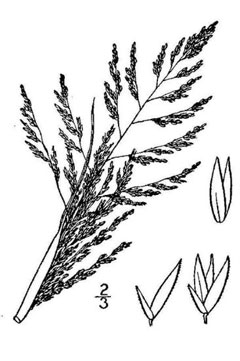 |
|
|
 |
| www.flickr.com/photos/plant_diversity/ |
Translate this page:
Summary
Physical Characteristics

 Sporobolus cryptandrus is a PERENNIAL growing to 1 m (3ft 3in).
Sporobolus cryptandrus is a PERENNIAL growing to 1 m (3ft 3in).
See above for USDA hardiness. It is hardy to UK zone 5. It is in flower from July to August. The species is hermaphrodite (has both male and female organs) and is pollinated by Wind.
Suitable for: light (sandy) and medium (loamy) soils and prefers well-drained soil. Suitable pH: mildly acid, neutral and basic (mildly alkaline) soils. It cannot grow in the shade. It prefers dry or moist soil. The plant can tolerate maritime exposure.
UK Hardiness Map
US Hardiness Map
Synonyms
Plant Habitats
Cultivated Beds;
Edible Uses
Edible Parts: Seed
Edible Uses:
Seed - raw or cooked[257]. It can be parched, ground into a flour and eaten dry or made into a mush[61, 101, 105, 183]. The ground seed can also be added to biscuits, breads and other cereal concoctions[183, 257]. The tiny seed is easily freed from its husks[183].
References More on Edible Uses
Medicinal Uses
Plants For A Future can not take any responsibility for any adverse effects from the use of plants. Always seek advice from a professional before using a plant medicinally.
None known
References More on Medicinal Uses
The Bookshop: Edible Plant Books
Our Latest books on Perennial Plants For Food Forests and Permaculture Gardens in paperback or digital formats.

Edible Tropical Plants
Food Forest Plants for Hotter Conditions: 250+ Plants For Tropical Food Forests & Permaculture Gardens.
More

Edible Temperate Plants
Plants for Your Food Forest: 500 Plants for Temperate Food Forests & Permaculture Gardens.
More

More Books
PFAF have eight books available in paperback and digital formats. Browse the shop for more information.
Shop Now
Other Uses
Brush Soil reclamation
A bunch of the grass, about 30cm long, can be tied together with string and used as a brush for cleaning[257].
Special Uses
References More on Other Uses
Cultivation details
Succeeds in any well drained soil in a sunny position[200].
References Carbon Farming Information and Carbon Sequestration Information
Temperature Converter
Type a value in the Celsius field to convert the value to Fahrenheit:
Fahrenheit:
The PFAF Bookshop
Plants For A Future have a number of books available in paperback and digital form. Book titles include Edible Plants, Edible Perennials, Edible Trees,Edible Shrubs, Woodland Gardening, and Temperate Food Forest Plants. Our new book is Food Forest Plants For Hotter Conditions (Tropical and Sub-Tropical).
Shop Now
Plant Propagation
Seed - sow spring in a greenhouse and only just cover the seed. Germination should take place within 2 weeks. Prick out the seedlings into individual pots when they are large enough to handle and plant them out in the summer if they have grown sufficiently. Otherwise, grow them on in a greenhouse for their first winter and plant them out in late spring of the following year. Division in spring. Larger divisions can be planted out direct into their permanent positions. We have found it best to pot up the smaller divisions and grow them on in a lightly shaded position in a cold frame, planting them out once they are well established in the summer.
Other Names
If available other names are mentioned here
Native Range
NORTHERN AMERICA: Canada (Québec (southwest), Ontario, Saskatchewan, Alberta (south), Manitoba, British Columbia (south)), United States (Indiana, Maine (southwest), Massachusetts (east), Michigan, New Hampshire (southeast), New York (east & north), Ohio, Pennsylvania (east), Vermont (south), Connecticut (southwest), Illinois, Iowa, Kansas, Minnesota, Missouri, Nebraska, North Dakota, Oklahoma, South Dakota, Wisconsin, Colorado, Idaho, Montana, Oregon, Washington, Wyoming, Alabama (east), Arkansas, Kentucky (west), Louisiana, South Carolina (east), Mississippi, Tennessee, New Mexico, Texas, Arizona, California, Nevada, Utah), Mexico (Baja, Chihuahua, Coahuila de Zaragoza, Nuevo León, Sonora, Tamaulipas, Baja California Sur) SOUTHERN AMERICA: Argentina
Weed Potential
Right plant wrong place. We are currently updating this section.
Please note that a plant may be invasive in one area but may not in your area so it's worth checking.
Conservation Status
IUCN Red List of Threatened Plants Status :

Growth: S = slow M = medium F = fast. Soil: L = light (sandy) M = medium H = heavy (clay). pH: A = acid N = neutral B = basic (alkaline). Shade: F = full shade S = semi-shade N = no shade. Moisture: D = dry M = Moist We = wet Wa = water.
Now available:
Food Forest Plants for Mediterranean Conditions
350+ Perennial Plants For Mediterranean and Drier Food Forests and Permaculture Gardens.
[Paperback and eBook]
This is the third in Plants For A Future's series of plant guides for food forests tailored to
specific climate zones. Following volumes on temperate and tropical ecosystems, this book focuses
on species suited to Mediterranean conditions—regions with hot, dry summers and cool, wet winters,
often facing the added challenge of climate change.
Read More
Expert comment
Author
(Torr.)A.Gray.
Botanical References
43235
Links / References
For a list of references used on this page please go here
Readers comment
© 2010, Plants For A Future. Plants For A Future is a charitable company limited by guarantee, registered in England and Wales. Charity No. 1057719, Company No. 3204567.